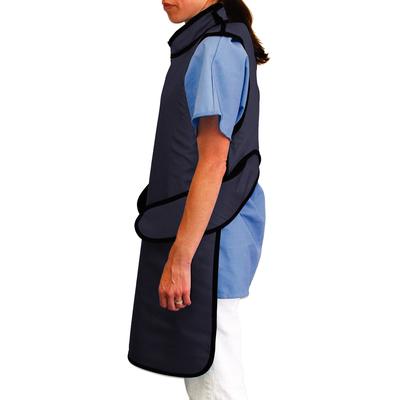

Limitation: Each individual must be protected against risks that are too great, through the application of individual radiation dose limits.Justification: No unnecessary use of radiation is permitted, which means that the advantages must outweigh the disadvantages.The ICRP uses the following overall principles for all controllable exposure situations. These can be such as from naturally occurring radioactive materials which exist in the environment.

Existing exposure – defined as ".being those that already exist when a decision on control has to be taken".This would be such as an emergency nuclear event.
 Emergency exposure – defined as ".unexpected situations that may require urgent protective actions". Planned exposure – defined as ".where radiological protection can be planned in advance, before exposures occur, and where the magnitude and extent of the exposures can be reasonably predicted." These are such as in occupational exposure situations, where it is necessary for personnel to work in a known radiation environment. The ICRP recognises planned, emergency, and existing exposure situations, as described below In most countries a national regulatory authority works towards ensuring a secure radiation environment in society by setting dose limitation requirements that are generally based on the recommendations of the ICRP. The ICRP's recommendations flow down to national and regional regulators, which have the opportunity to incorporate them into their own law this process is shown in the accompanying block diagram. The system's health objectives are "to manage and control exposures to ionising radiation so that deterministic effects are prevented, and the risks of stochastic effects are reduced to the extent reasonably achievable". The ICRP recommends, develops and maintains the International System of Radiological Protection, based on evaluation of the large body of scientific studies available to equate risk to received dose levels. Principles International policy relationships in radiological protection.The ICRP is generally recognised by regulators as the International authority on good practice External dose quantities used in radiation protection and dosimetry - based on ICRU report 57 Graphic showing relationships between radioactivity and detected ionizing radiation To measure personal dose uptake in occupational or emergency exposure, for external radiation personal dosimeters are used, and for internal dose to due to ingestion of radioactive contamination, bioassay techniques are applied.įor radiation protection and dosimetry assessment the International Commission on Radiation Protection (ICRP) and International Commission on Radiation Units and Measurements (ICRU) publish recommendations and data which is used to calculate the biological effects on the human body of certain levels of radiation, and thereby advise acceptable dose uptake limits. The duration of exposure should be limited to that necessary, the distance from the source of radiation should be maximised, and the source or the target shielded wherever possible. For low level exposures there can be statistically elevated risks of radiation-induced cancer, called " stochastic effects" due to the uncertainty of them happening, conventionally indicated by the unit sievert.įundamental to radiation protection is the avoidance or reduction of dose using the simple protective measures of time, distance and shielding. At high exposures, it can cause "tissue" effects, also called "deterministic" effects due to the certainty of them happening, conventionally indicated by the unit gray and resulting in acute radiation syndrome. There are two main categories of ionizing radiation health effects. Ionizing radiation is widely used in industry and medicine, and can present a significant health hazard by causing microscopic damage to living tissue. Exposure can be from a source of radiation external to the human body or due to internal irradiation caused by the ingestion of radioactive contamination. Radiation protection, also known as radiological protection, is defined by the International Atomic Energy Agency (IAEA) as "The protection of people from harmful effects of exposure to ionizing radiation, and the means for achieving this".
Emergency exposure – defined as ".unexpected situations that may require urgent protective actions". Planned exposure – defined as ".where radiological protection can be planned in advance, before exposures occur, and where the magnitude and extent of the exposures can be reasonably predicted." These are such as in occupational exposure situations, where it is necessary for personnel to work in a known radiation environment. The ICRP recognises planned, emergency, and existing exposure situations, as described below In most countries a national regulatory authority works towards ensuring a secure radiation environment in society by setting dose limitation requirements that are generally based on the recommendations of the ICRP. The ICRP's recommendations flow down to national and regional regulators, which have the opportunity to incorporate them into their own law this process is shown in the accompanying block diagram. The system's health objectives are "to manage and control exposures to ionising radiation so that deterministic effects are prevented, and the risks of stochastic effects are reduced to the extent reasonably achievable". The ICRP recommends, develops and maintains the International System of Radiological Protection, based on evaluation of the large body of scientific studies available to equate risk to received dose levels. Principles International policy relationships in radiological protection.The ICRP is generally recognised by regulators as the International authority on good practice External dose quantities used in radiation protection and dosimetry - based on ICRU report 57 Graphic showing relationships between radioactivity and detected ionizing radiation To measure personal dose uptake in occupational or emergency exposure, for external radiation personal dosimeters are used, and for internal dose to due to ingestion of radioactive contamination, bioassay techniques are applied.įor radiation protection and dosimetry assessment the International Commission on Radiation Protection (ICRP) and International Commission on Radiation Units and Measurements (ICRU) publish recommendations and data which is used to calculate the biological effects on the human body of certain levels of radiation, and thereby advise acceptable dose uptake limits. The duration of exposure should be limited to that necessary, the distance from the source of radiation should be maximised, and the source or the target shielded wherever possible. For low level exposures there can be statistically elevated risks of radiation-induced cancer, called " stochastic effects" due to the uncertainty of them happening, conventionally indicated by the unit sievert.įundamental to radiation protection is the avoidance or reduction of dose using the simple protective measures of time, distance and shielding. At high exposures, it can cause "tissue" effects, also called "deterministic" effects due to the certainty of them happening, conventionally indicated by the unit gray and resulting in acute radiation syndrome. There are two main categories of ionizing radiation health effects. Ionizing radiation is widely used in industry and medicine, and can present a significant health hazard by causing microscopic damage to living tissue. Exposure can be from a source of radiation external to the human body or due to internal irradiation caused by the ingestion of radioactive contamination. Radiation protection, also known as radiological protection, is defined by the International Atomic Energy Agency (IAEA) as "The protection of people from harmful effects of exposure to ionizing radiation, and the means for achieving this". 
( Learn how and when to remove this template message) ( May 2020) ( Learn how and when to remove this template message) Statements consisting only of original research should be removed. Please improve it by verifying the claims made and adding inline citations. This article possibly contains original research.








 0 kommentar(er)
0 kommentar(er)
